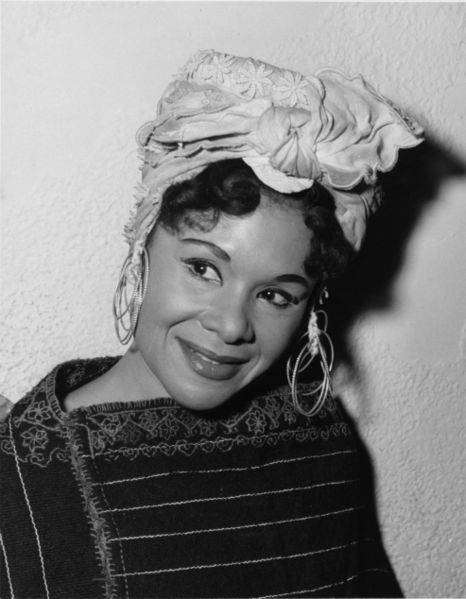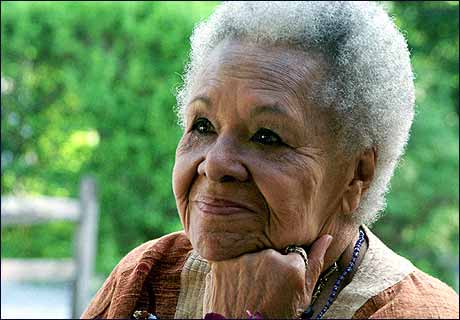Katherine Mary Dunham June 22, 1909-May 21, 2006 Dancer, Choreographer

Ms Dunham in 1956
From Wikipedia
Katherine Mary Dunham (22 June 1909 – 21 May 2006) was an American dancer, choreographer, songwriter, author, educator and activist who was trained as an anthropologist. Dunham had one of the most successful dance careers in American and European theater of the 20th century and has been called the Matriarch and Queen Mother of Black Dance. During her heyday in the 1940s, 50s and 60s, she was renowned throughout Europe and Latin America as La Grande Katherine, and the Washington Post called her "Dance's Katherine the Great." For more than 30 years she maintained the Katherine Dunham Dance Company, the only permanent, self-subsidized American black dance troupe at that time, and over her long career she choreographed more than 90 individual dances. Dunham was an innovator in African-American modern dance as well as a leader in the field of Dance Anthropology, or Ethno choreology (see also Dance Studies). In 1992, at the age of 82, Katherine Dunham went on a highly publicized 47-day hunger strike to protest what she condemned as the discriminatory U.S. foreign policy against Haitian boat-people. In 2002, scholar Molefi Kete Asante listed Katherine Dunham on his list of 100 Greatest African Americans. She died in her sleep in New York City on 21 May 2006.
While doing graduate work in 1935-1936, she was awarded Travel Fellowships from the Julius Rosenwald and Guggenheim Foundations to conduct ethnographic study of the dance forms of the Caribbean, especially as manifested in the Vodun of Haiti, a path also followed by fellow anthropology student, Zora Neale Hurston [1]; Professor Melville Herskovits of Northwestern University helped to provide the tutelage and preparation for her voyage. Dunham's ground-breaking "field work helped to develop a now recognized subdiscipline of anthropology and also led to Ms. Dunham's own understanding - both intellectual and kinesthetic - of the African roots of black dance in the Caribbean" and the USA. In 1939 she submitted her thesis, entitled "Dances of Haiti, Their Social Organization, Classification, Form and Function.
Her stay in the Caribbean began in Jamaica, where she went to live several months in the remote isolated Maroon village of Accompong, deep in the Cockpit Country, and she later wrote a book, "Journey to Accompong" describing those experiences. Then she traveled on to Martinique and Trinidad and Tobago for short stays (primarily to do an investigation of Shango, the African God who remained an important presence in West Indian heritage) before arriving in Haiti, where she remained for several months, the first of her many extended stays in that country throughout the rest of her life.
While in Haiti, she investigated Voodoo rituals and years later, after extensive studies and initiations, she became a mambo (priestess) in the Vaudon religion. She also became friends with, among others, Dumarsais Estimé, then a high level politician, who later became President of Haiti in 1949. Somewhat later, she assisted him, at considerable risk to her life, when he was persecuted for his progressive policies and sent in exile to Jamaica after a coup-d'état.
When she returned to Chicago in 1936 she was awarded her Bachelor's degree in Social Anthropology. As a result of her academic research "she acquired the title of 'dancing anthropologist' and actually founded the field of dance anthropology because of her intense study of African-influenced dance in the western hemisphere. This academic undertaking would also lead to the emergence and codification of the Dunham Technique, a dance technique utilizing African drums and rhythms as well as ballet and modern dance."
While working on her masters degree, she was told by her advisers that she had to choose between anthropology and dance. Much to their regret, although she was offered another grant from the Rockefeller Foundation, she decided to choose dance, left her graduate studies before finishing her doctorate, and departed for the bright lights of Broadway and Hollywood.


3 comments:
Thank you for this, Savannah.
A life lived full. I keep comparing the two pictures -- they are from almost the same angle. How old is she in the second picture? She has the same wry smile in both.
This picture is from an article published in 2002 when Ms Dunham was 93.
Love her.
Post a Comment